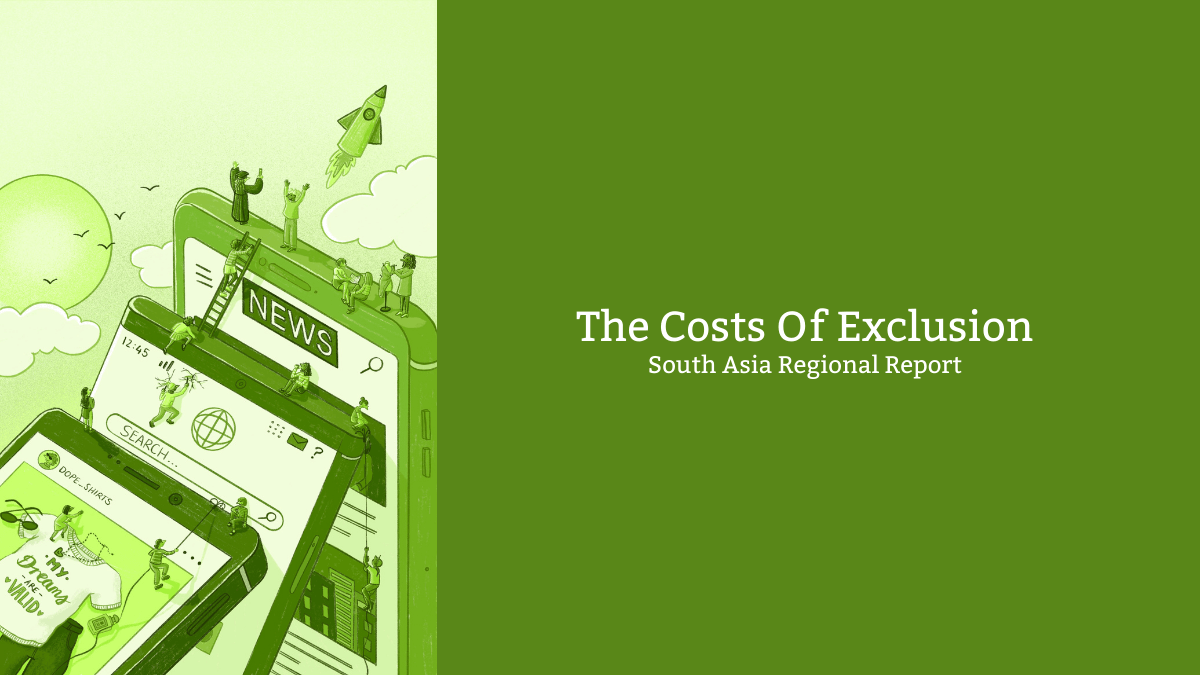The Costs of Exclusion research series has a message for broadband policymakers: the digital gender gap is real, it’s sexist, and it’s costing all of us over a trillion in lost economic productivity.
Now, our latest report zooms in on women’s experiences across South Asia – a region with one of the world’s largest digital gender gaps according to GSMA. It includes interviews and focus groups in India and Bangladesh and a telephone survey in India.
Here are the top takeaways from our latest report »
- Women are already achieving their dreams online. Our research participants are working online as chefs and personal trainers, spiritual leaders and medical professionals, dieticians and comedians, writers and musicians. The breadth of careers we encountered speaks not just to the diversity of dreams and talents held by women across the region but also the depth of economic potential left untapped due to digital gender inequality in the region.
- That the women we spoke to have reliable and regular internet access makes them the exception to the rule. A number of barriers limit most women’s use of the internet, including social, economic, and structural limitations. These barriers accumulate into one of the world’s largest gender gaps remaining stagnant throughout South Asia.
- Those that are able to succeed as online entrepreneurs frequently have other social advantages. These primarily come in the form of privilege by class, education, or family. These privileges enable some women, but not all, to get online and get ahead, and stress the importance of policy intervention to ensure that this technology enables widespread benefits for all, not just those lucky by birth.
- The education gap builds into an infrastructure gap. In our survey, women with a secondary education or more were significantly more likely to own a smartphone rather than a more simple device. Among non-internet users, this difference grew as stark as a woman with a post-secondary education who did not even use the internet being five times more likely to own a smartphone than her peer who did not complete secondary school. Where inequality discourages girls’ education, this starts a chain reaction that reinforces the digital gender gap.
- In addition to infrastructure, education and gender influences where internet use is perceived as acceptable Among our respondents, internet use at home was widespread and common. When prompted about where else they used the internet, women with a secondary education were more likely to use the internet than women without such an education in every location we measured.
- This education-infrastructure-location gap has a strong myth-building potential. By creating the evidence that, in general, only well-educated or rich women (or any other specific class of women) are using the internet, this infrastructure gap creates the myth that only some women should use the internet. In turn, it creates social evidence that discourages women’s use of the internet and makes it harder for us to confront the digital gender gap.
- Across a wide array of topics, women who used the internet felt more confident about finding information than their unconnected peers did. This remains true even when controlling for education, and interestingly, internet access correlates with an informational ‘leap-frogging’ effect where women without a secondary education who use the internet were more confident in finding a piece of information in each of our nine prompts compared to women with post-secondary qualifications who did not use the internet. This stresses the value of widespread internet access for everyone, regardless of gender, education, or background.
This research series illustrates the importance of addressing the digital gender gap. In a vacuum of adequate policy action, women are still breaking through to achieve incredible things. However, frequently, they do so with access to other forms of privilege that enable them to overcome the barriers to women’s internet use. The digital gender gap operates in several ways, just as there are several individual and societal benefits to increasing women’s internet use.
We have the evidence and the means to overcome this problem – we now just need to rally the political will to confront the digital gender gap.
For more updates, follow us on Twitter at @webfoundation and sign up to receive our newsletter and The Web This Week, a weekly news brief on the most important stories in tech.
Tim Berners-Lee, our co-founder, gave the web to the world for free, but fighting for it comes at a cost. Please support our work to build a safe, empowering web for everyone.
